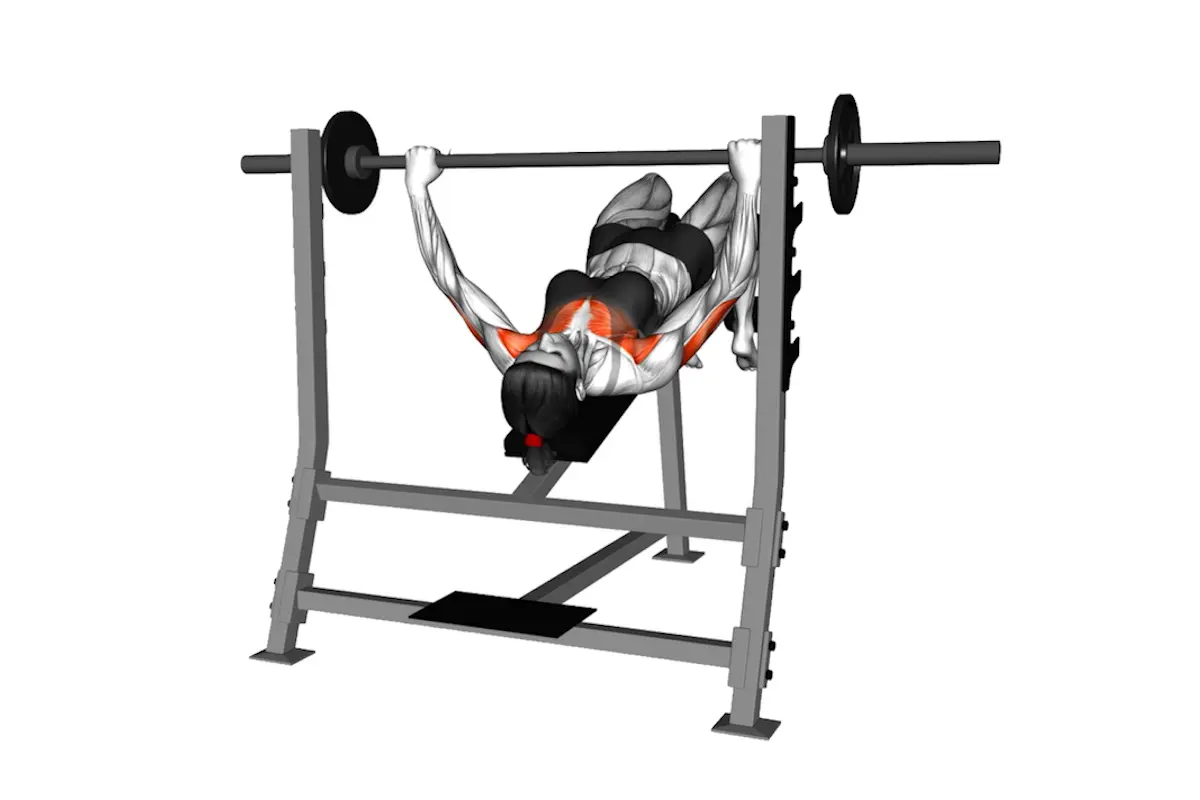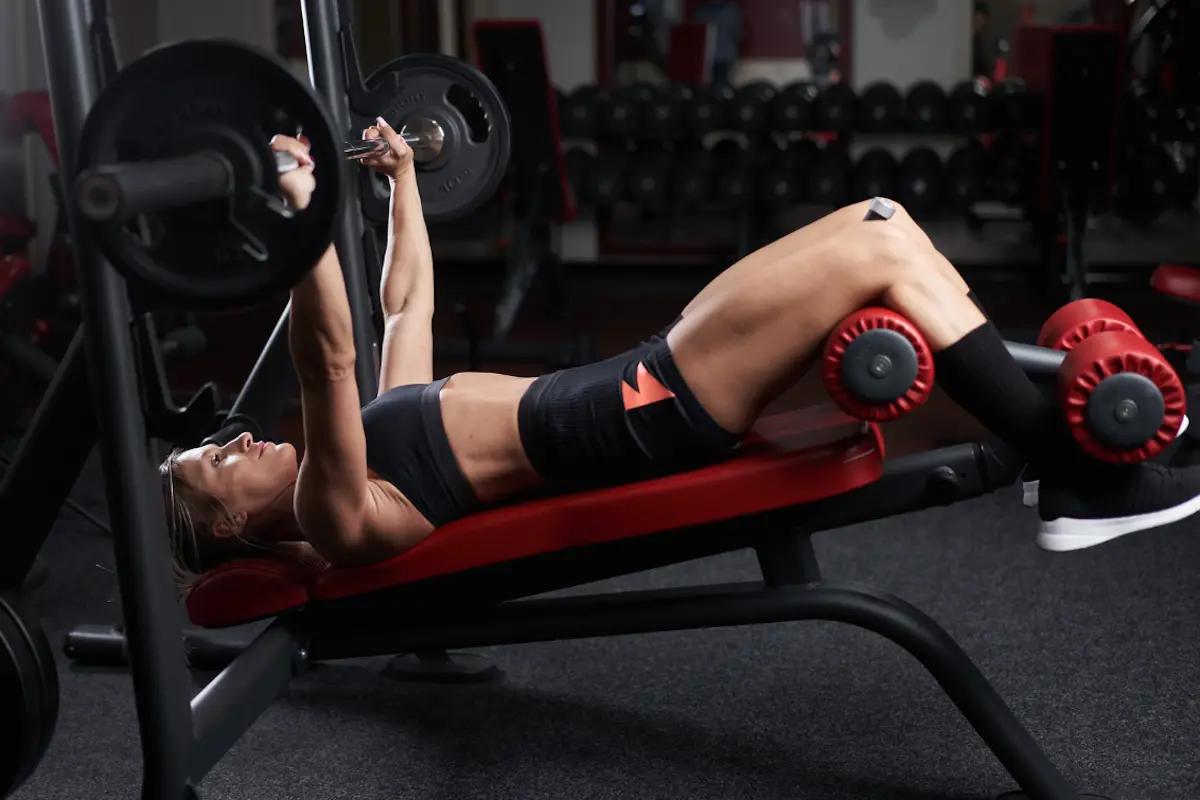Why You Should Include Decline Bench Press in Training

What's In This Article
- Key Highlights
- Introduction
- Key Points of the Decline Bench Press
- Main Benefits of Including Decline Bench Press
- Muscle Activation During the Decline Bench Press
- Proper Decline Bench Press Technique
- Conclusion
- Frequently Asked Questions
- References
- Resources
Key Highlights
- The decline bench press is a crucial barbell bench variation that targets the lower pectoral muscles, offering unique benefits for your chest workout routine.
- Benching at this angle reduces strain on the shoulders and lower back compared to flat or incline positions, making it a safer choice for some individuals.
- Including this movement can break through chest training plateaus by enhancing muscle activation in underused areas.
- The proper starting position and form is essential for maximising muscle mass and avoiding injury during bench pressing.
- Utilising free weights in the decline position brings additional stabiliser muscles into play, supporting comprehensive upper body development.
- By integrating this exercise into your program, you gain improved definition, varied muscle engagement, and a balanced chest appearance.
Introduction
Optimising your chest strength and size means exploring beyond the traditional incline and flat bench exercises. The decline press stands out amongst chest exercises for its unique ability to target the lower pecs and reduce joint stress.
Adding this variation not only diversifies muscle activation but can also help reduce your risk of common injuries. Understanding its benefits and the safest way to execute the movement will help you maximise your results and achieve a fuller, stronger chest.
As a powerlifting coach, I've seen athletes overlook the decline press in favour of its more popular counterparts, missing out on significant strength gains and aesthetic improvements.
In my experience, incorporating decline work has helped many of my lifters break through benching plateaus while developing lower chest strength and functionality.

Key Points of the Decline Bench Press
The decline bench press is a barbell press variation where the bench is set at a downward angle, typically between 15 and 30 degrees.
- This starting position shifts your upper body below your hips, emphasising the lower chest muscles more than flat or incline options.
- Many lifters choose this approach to target chest muscles that often remain underdeveloped with conventional routines.
- This variation enhances lower pectoral recruitment and allows you to press substantial weight with less shoulder involvement. This makes it a valuable addition for those aiming to build muscle mass safely while maintaining joint health.
How the Decline Bench Press Differs from Flat and Incline Variations
Research comparing bench positions (incline, flat, and decline) in competitive athletes found that the decline bench tends to emphasise activation in the lower sternal portion of the pectoralis major, while the incline targets upper portions (Saeterbakken et al., 2017; Lopez-Vivancos et al., 2023).
- On a decline, your body is positioned so your head is lower than your hips, which places most of the load on the lower chest (lower pec) and reduces strain on the shoulder joint.
- In contrast, the flat bench press targets the entire chest but distributes the load evenly, engaging both upper and lower pecs.
- Switching to an incline bench shifts the emphasis to the upper chest (upper pecs) and anterior deltoids, increasing shoulder muscle activation. This makes incline pressing more challenging for the shoulders and limits the weight you can use.
Equipment Needed for the Decline Bench Press
- Decline bench: Adjustable to 15-30 degrees decline, with ankle supports for stability in the decline position.
- Free weights: Either a barbell or a pair of dumbbells for the pressing movement.
- Spotter or safety racks: Recommended for heavy lifts to ensure safe pressing.
The right equipment not only supports proper form but also enables varied training so that you can adapt your program for individual goals.

Main Benefits of Including Decline Bench Press
Some coaches view specific variations as unnecessary for most gym goers. Mike Boyle, MBSC, a well-respected strength and conditioning coach, emphasises well-rounded strength and considers over-emphasis on variations —including declines—less critical for athletes.
He focuses his programs on movements like the flat or overhead press, and suggests other lifts are usually more functional for sports performance. However, as a strength and powerlifting coach, I see the value in working on specific muscle areas or weak points in a main lift.
Dane Miller, owner and founder of Garage Strength Sports Performance, points out, “Think about the decline as a tool to get stronger, improve lockout, improve shoulder girdle and pec strength, and improve elbow extension", and SBD Apparel, arguably the most well-known powerlifting clothing brand, endorses the decline bench in their blog.
Enhanced Lower Pec Development
One of the most compelling reasons to include the decline press in your program is its unique impact on the lower chest.
- Review studies of EMG data have shown that by adjusting the bench to a decline, you align the pressing motion directly with the lower sternal portion of the pectoralis major fibres, maximising their activation (El-Gazzar, 2024).
Improved Upper Body Strength and Power
This exercise is not just about aesthetics; it also offers significant benefits for upper body strength and power.
- EMG data studies have shown that pressing from a decline position allows you to handle heavier weights compared to incline variations, as the angle reduces the range of motion and shifts the load away from the shoulders (Rodriguez-Ridao et al., 2020).
- This can be a game-changer if you've hit a plateau in your training. The unique muscle activation pattern, focusing on the lower pecs and triceps, provides a new challenge for your muscles, helping you continue progressing, overload and increase strength.
Muscle Activation During the Decline Bench Press
- In this exercise, the pectoralis major—especially the sternal head or lower pec—takes on the majority of the work.
- The triceps brachii and anterior deltoid also play supporting roles, helping you control both the lowering and lifting phases.
- This different activation pattern distinguishes the decline press from flat or incline options.
Primary Muscles Targeted
Here’s a comparison in a text table for muscle activation across variations:
|
Muscle Group |
Incline Bench Press |
Flat Bench Press |
Decline Bench Press |
|
Pectoralis Major (Upper) |
High (Peak at 30°) |
Moderate |
Moderate-High |
|
Pectoralis Major (Middle) |
Moderate |
High (Peak) |
High |
|
Pectoralis Major (Lower) |
Low-Moderate |
High (Peak) |
Highest |
|
Anterior Deltoid |
Highest |
High |
Moderate |
|
Triceps Brachii |
58-63% Lower than flat |
High (Peak) |
High (Peak) |
|
Biceps Brachii |
48-69% Higher than flat |
Moderate |
Low |
Supporting Stabiliser Muscles Engaged
Stabiliser muscles play a critical role in maintaining control and safety.
- The decline position requires strong engagement from the core and lower back to keep your body stable on the angled surface.
- The shoulder joint also benefits from less strain while still activating supporting muscles to guide the movement safely.
Proper Decline Bench Press Technique
Proper technique ensures optimal muscle activation in the lower chest and triceps while minimising stress on the shoulders and lower back.
Step-by-Step Guide to Performing the Movement
Performing the movement safely and efficiently requires a step-by-step approach. Start by ensuring the decline is set at 15-30 degrees and your feet are firmly secured.
- Lie back with your eyes directly under the barbell and grip the bar slightly wider than shoulder width.
- Unrack the bar and hold it above your chest with straight arms.
- Lower the bar slowly to the lower portion of your chest, keeping elbows at about a 45-degree angle.
- Pause, then press the bar upward to full arm extension, locking out at the top.
Repeat this motion for your desired number of repetitions. Remember to engage your core throughout and ask for a spotter if lifting heavy weights.
Technical Errors and Fixes
- Using excessive weight before mastering form - Start with lighter weights and focus on proper technique first.
- Bouncing the bar off the chest - Pause at the bottom and press with control instead of using momentum.
- Arching the lower back excessively - Maintain neutral spine position throughout the movement.
- Letting elbows flare out too wide - Keep elbows at a 45-degree angle to protect shoulder joints.
- Lowering the bar too high on the chest - Aim for the lower chest/sternum area to target the lower pecs appropriately.
- Not securing feet properly - Ensure feet are firmly planted and locked in position for stability.
- Rushing through the movement - Use a deliberate, controlled tempo throughout the entire range of motion.
- Training without a spotter on heavy weights - Always use a spotter when lifting challenging loads.
Conclusion
By targeting the lower chest and improving overall upper body strength, this exercise fills an essential role in diverse strength training programs. Understanding proper technique and avoiding mistakes are crucial for maximising benefits and ensuring safety.
If you're looking for tailored advice on technique or on optimising your training, get in touch for a free consultation.
Frequently Asked Questions
Is the Decline Bench Press Suitable for Beginners, or Should I Start Elsewhere?
While beginners can perform it, it’s recommended to master the flat barbell press first. The movement requires a stable starting position, proper grip, and awareness of safety. Start light, focus on technique, and only progress when you feel confident in your form.
Are there any risks or downsides associated with doing the decline bench press regularly?
Regular use has some potential downsides, including shoulder strain if performed with improper form and an awkward positioning that can feel uncomfortable and take time to get used to.
The angle can also make it more challenging to get in and out of position safely, and the exercise doesn't recruit stabilising shoulder muscles as effectively as flat pressing, potentially leading to muscle imbalances if it's your primary chest exercise.
Can the Decline Bench Press Help Break Through a Lifting Plateau?
Yes, it can help overcome a chest plateau. By introducing new muscle activation patterns and targeting the lower pec region, it stimulates fresh growth and muscle mass. This variation also allows you to lift heavier, contributing to overall press and upper body progress.
Are There Effective Alternatives if I Don’t Have a Decline Bench Available?
If you lack a decline bench, alternatives include decline push-ups, floor dumbbell presses, or performing dumbbell chest exercises on an inclined bench set at a slight decline. Incline press and dips also offer some lower chest activation, allowing flexibility in your training routine.
How does decline bench press compare to flat and incline press in terms of muscle engagement?
It places greater emphasis on the lower pec, while the flat press involves both upper and lower chest, and the incline press shifts focus to the upper chest and shoulders. Each variation alters muscle engagement and helps target the entire pec.
What are the benefits of incorporating decline bench press into a workout routine?
Including this movement enhances lower chest growth, supports greater overall muscle mass, and reduces joint strain. This exercise promotes balanced pectoralis significant development and helps break through training plateaus.
References
- El-Gazzar, H. A. E. M. (2024). Bench press exercise the greatest functionally and biomechanically drill. Journal of Applied Sports Science, 14(1). Retrieved from jass.alexu.edu.eg
- López-Vivancos, A., González-Gálvez, N., Orquin, F. J., & Vale, R. (2023). Electromyographic activity of the pectoralis major muscle during traditional bench press and other variants of pectoral exercises: A systematic review and meta-analysis. Applied Sciences, 13(8), 5203.
- Rodríguez-Ridao, D., Antequera-Vique, J. A., Martín-Fuentes, I., & Muyor, J. M. (2020). Effect of five bench inclinations on the electromyographic activity of the pectoralis major, anterior deltoid, and triceps brachii during the bench press exercise. International Journal of Environmental Research and Public Health, 17(19), 7339.
- Saeterbakken, A. H., Mo, D. A., Scott, S., & Andersen, V. (2017). The effects of bench press variations in competitive athletes on muscle activity and performance. Journal of Human Kinetics, 57, 61-71.